Here, I show a new cattle-handling unit, which incorporates the latest features that prioritise labour efficiency and safety for both humans and stock. It’s on the farm of well-known farming brothers Gabriel and Michael Hoey, who own the thriving food firm Country Crest.
This handling unit is set up out in the grazing fields, but it would be equally well suited in a farmyard.
The location suits the Hoey farm as it means cattle can be handled in the fields without having to be brought into the busy main yard. Gabriel has a smaller handling unit in the beef shed.
Among the main requirements of a cattle-handling unit are that it is:
Contained: Cattle cannot escape and run up the lane or across fields.Penned: The movement of cattle is controlled and can be done in batches, so that cattle can be circulated around a unit and let back out to where they came from.Labour-efficient: Nowadays, this means having a funnel directing cattle calmly into the chute and a forcing gate to allow them be safely moved forwards. Slip-through gaps eliminate the need to open gates or – worse – climb over.Safe for operators: Cattle and humans don’t mix. Slip-through gaps and a catwalk over the chute add to safety. Safe for cattle: Factors here are non-slip surfaces, secure barriers of sufficient height with adequate gaps between rails and a working head gate. Features which keep cattle calm – such as a funnel – also help. Picture one
The steelwork here was supplied by Condon Engineering, Collon, Co Louth.The unit is square-shaped. On the right is the chute and head gate, with the forcing gate and funnel to feed in cattle.
Picture two
To the left are three large holding pens. Overall, the unit is 40m long and 40m wide. Cattle enter the unit through the large pen, through double gates. It measures 40m by 20m and will hold 50 cattle.
Picture three
Cattle then enter the forcing pen and funnel. The sides of the funnel curve towards the opening of the chute, giving cattle nowhere to turn and narrowing them into a single file. If stock are nervous, sheeting the sides of a funnel can help to keep them calm and moving forward.
Pictures four and five
A forcing gate in a circular forcing pen is an effective way to push cattle forward without the risk of being kicked. The gate rotates on the 8in centre pillar concreted into the ground. The gate hugs the sides of the forcing pen, leaving no gaps.
The gate has a stop mechanism (picture five) with catches every 2ft to stop the gate being pushed back on to the operator if an animal reverses.
Picture six
The chute is four-rail and 30in wide. It has four panels (32ft long). The metal work here is robust. The tubes are 75mm in diameter and made of 5mm wall. The rails are 48mm in diameter and made of 3mm wall. There is a 405mm (16in) gap between the rails to reduce the risk of an animal’s head getting trapped.
The concrete floor will stay clean. A stone surface would hollow down into a path and then collect water and dirt.
Picture seven
A catwalk brings the operator over the animal and makes work easier. This one is securely fixed on to the chute panels and the open mesh has good grip for boots. This one is set at the right height – any higher would be very tiring for the cattle after an hour or two jumping up and down. In any case, it is adjustable and can be removed if that suits certain jobs.
The headgate (pictured right) is semi-automatic. The operator area, alongside the chute and headgate, is fenced off from cattle with a barrier. This is important for safety. Vet equipment, cards, medicines and coats can be put safely on a table. There are a number of narrow slip-through gaps for easy movement around the unit by the operator. The gap here gives access to the outside of the chute and the other side of the animal, if necessary. The 15in-wide gaps are unobtrusive and not directly in front of the animals. They move through the pens into the funnel and chute.
Here, I show a new cattle-handling unit, which incorporates the latest features that prioritise labour efficiency and safety for both humans and stock. It’s on the farm of well-known farming brothers Gabriel and Michael Hoey, who own the thriving food firm Country Crest.
This handling unit is set up out in the grazing fields, but it would be equally well suited in a farmyard.
The location suits the Hoey farm as it means cattle can be handled in the fields without having to be brought into the busy main yard. Gabriel has a smaller handling unit in the beef shed.
Among the main requirements of a cattle-handling unit are that it is:
Contained: Cattle cannot escape and run up the lane or across fields.Penned: The movement of cattle is controlled and can be done in batches, so that cattle can be circulated around a unit and let back out to where they came from.Labour-efficient: Nowadays, this means having a funnel directing cattle calmly into the chute and a forcing gate to allow them be safely moved forwards. Slip-through gaps eliminate the need to open gates or – worse – climb over.Safe for operators: Cattle and humans don’t mix. Slip-through gaps and a catwalk over the chute add to safety. Safe for cattle: Factors here are non-slip surfaces, secure barriers of sufficient height with adequate gaps between rails and a working head gate. Features which keep cattle calm – such as a funnel – also help. Picture one
The steelwork here was supplied by Condon Engineering, Collon, Co Louth.The unit is square-shaped. On the right is the chute and head gate, with the forcing gate and funnel to feed in cattle.
Picture two
To the left are three large holding pens. Overall, the unit is 40m long and 40m wide. Cattle enter the unit through the large pen, through double gates. It measures 40m by 20m and will hold 50 cattle.
Picture three
Cattle then enter the forcing pen and funnel. The sides of the funnel curve towards the opening of the chute, giving cattle nowhere to turn and narrowing them into a single file. If stock are nervous, sheeting the sides of a funnel can help to keep them calm and moving forward.
Pictures four and five
A forcing gate in a circular forcing pen is an effective way to push cattle forward without the risk of being kicked. The gate rotates on the 8in centre pillar concreted into the ground. The gate hugs the sides of the forcing pen, leaving no gaps.
The gate has a stop mechanism (picture five) with catches every 2ft to stop the gate being pushed back on to the operator if an animal reverses.
Picture six
The chute is four-rail and 30in wide. It has four panels (32ft long). The metal work here is robust. The tubes are 75mm in diameter and made of 5mm wall. The rails are 48mm in diameter and made of 3mm wall. There is a 405mm (16in) gap between the rails to reduce the risk of an animal’s head getting trapped.
The concrete floor will stay clean. A stone surface would hollow down into a path and then collect water and dirt.
Picture seven
A catwalk brings the operator over the animal and makes work easier. This one is securely fixed on to the chute panels and the open mesh has good grip for boots. This one is set at the right height – any higher would be very tiring for the cattle after an hour or two jumping up and down. In any case, it is adjustable and can be removed if that suits certain jobs.
The headgate (pictured right) is semi-automatic. The operator area, alongside the chute and headgate, is fenced off from cattle with a barrier. This is important for safety. Vet equipment, cards, medicines and coats can be put safely on a table. There are a number of narrow slip-through gaps for easy movement around the unit by the operator. The gap here gives access to the outside of the chute and the other side of the animal, if necessary. The 15in-wide gaps are unobtrusive and not directly in front of the animals. They move through the pens into the funnel and chute.



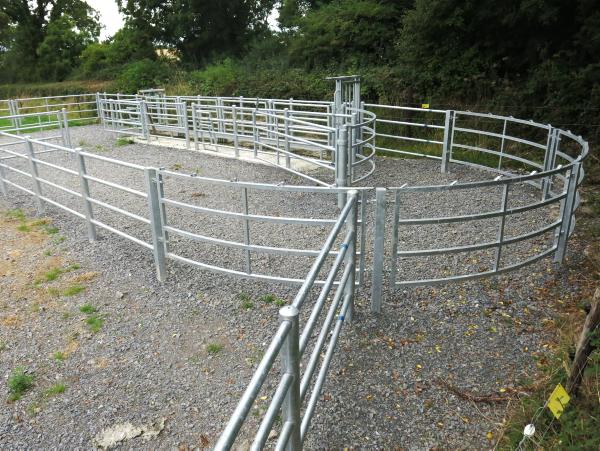

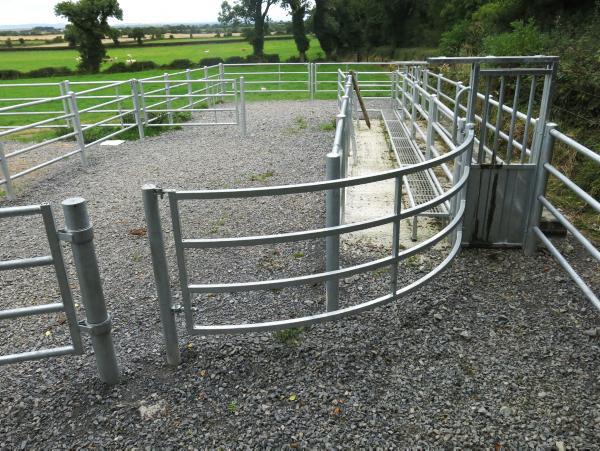

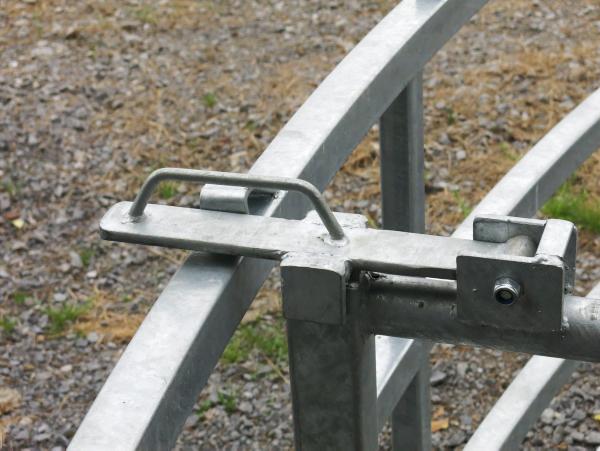
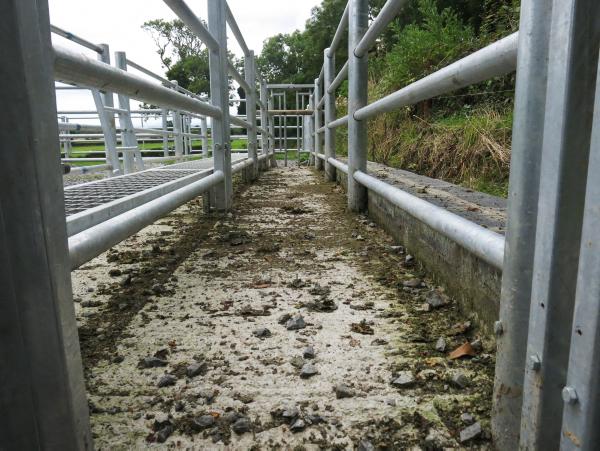
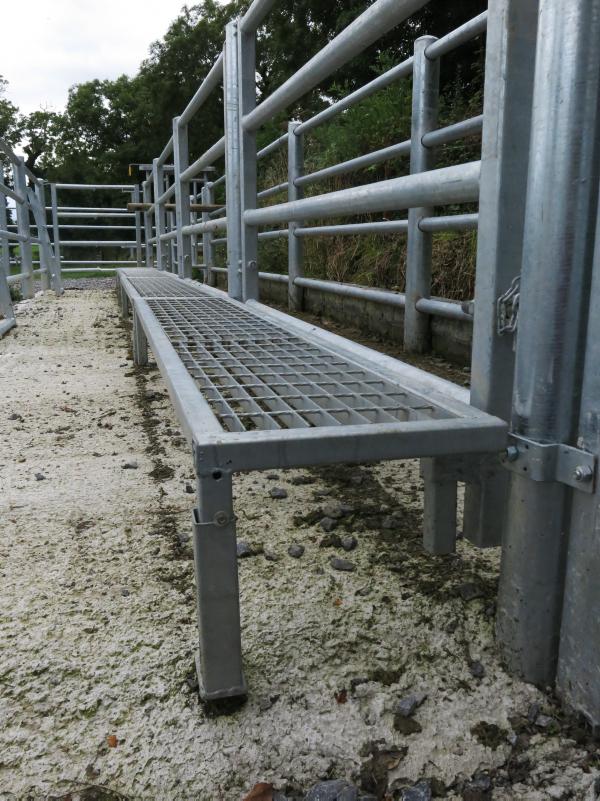


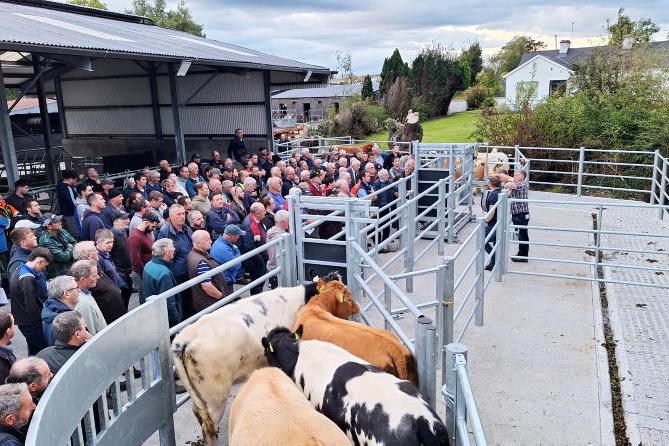


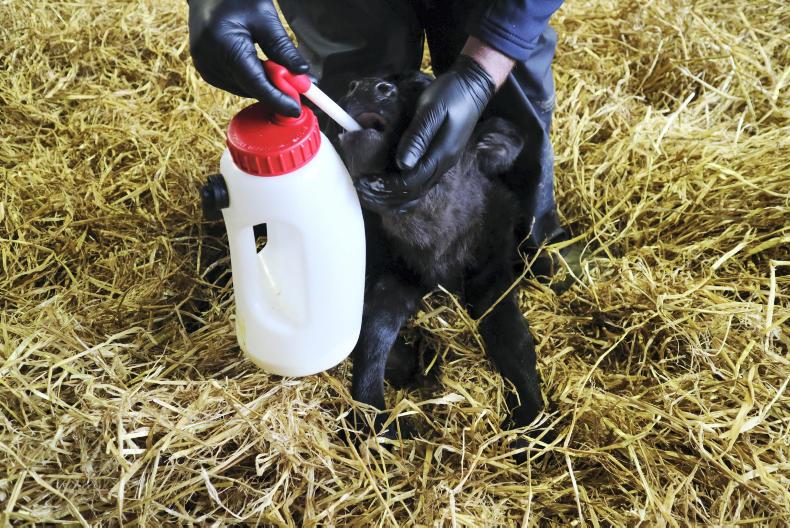

SHARING OPTIONS